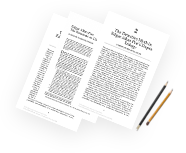Case Presentation
For this activity, we will focus on presenting patients in addition to assessing clinical reasoning. Students will select a patient from the clinical setting that presents with a complaint consistent with the topical content for the course week.
Presentations need to follow SOAP format with reflections. Address the following:
- Subjective (S) =chief complaint or reason patient presented for treatment with pertinent historical information including PMH, Medication, Allergies, PSH, SH, and ROS.
- Objective (O) =exam findings relevant to the chief complaint or reason for a visit including any diagnostic tests [labs or imaging] done at the point of care.
- Assessment (A) = most probable diagnosis includes at least 2 differential diagnoses for the acute problem [new problem] and status of any chronic conditions listed in order of priority.
- Plan (P) =include all appropriate treatment as well as a written prescription and management of all diagnoses addressed during the visit including patient education, health promotion and disease prevention [age appropriate].
- Document the current CPT billing codes for an office visit (level of service) and testing conducted during the office visit.
- Reflections- what did you learn, and would you do anything differently (if any)
Expert Solution Preview
Introduction:
In this assignment, students will be required to present a patient case using the SOAP format, while also demonstrating their clinical reasoning skills. The objective of this activity is to assess students’ ability to gather subjective and objective information, develop an accurate assessment, create a appropriate treatment plan, and reflect upon their learning experience. Additionally, students will need to include relevant billing codes for an office visit and any testing conducted during the patient encounter. This assignment will help students enhance their practical skills and critical thinking abilities.
Answer to the Content:
For this assignment, students are expected to:
1. Subjective (S): Begin by stating the patient’s chief complaint or reason for seeking treatment. Include pertinent historical information such as the patient’s past medical history (PMH), current medications, allergies, past surgical history (PSH), social history (SH), and review of systems (ROS). This section should provide a comprehensive overview of the patient’s subjective experience and background information.
2. Objective (O): Present the relevant physical examination findings that are directly related to the chief complaint or reason for the visit. Include any diagnostic tests (labs or imaging) that were conducted at the point of care. This section should provide an objective assessment of the patient’s condition.
3. Assessment (A): Provide a diagnosis based on the most probable condition, along with at least two differential diagnoses for the acute problem. Additionally, mention the current status of any chronic conditions, prioritizing them accordingly. This section should demonstrate the student’s ability to analyze and think critically about the patient’s condition.
4. Plan (P): Present an appropriate treatment plan, including any necessary interventions, medications, and referrals. Provide a written prescription if applicable. Also, address the management of all diagnoses discussed during the visit, including patient education on health promotion and disease prevention, tailored to the patient’s age. This section should showcase the student’s ability to formulate an effective plan of care.
5. Billing Codes: Document the current CPT billing codes for the office visit, specifying the level of service provided. Additionally, include any relevant codes for testing conducted during the office visit. This section requires students to demonstrate their understanding of medical coding and billing practices.
6. Reflections: Finally, students should reflect upon their learning experience during this activity. They should discuss what they have learned from the case presentation and whether they would approach anything differently in the future. This reflection allows students to critically evaluate their performance and identify areas for improvement.
Overall, this assignment aims to assess students’ clinical reasoning skills, knowledge of medical coding, and their ability to critically reflect upon their experiences. By completing this activity, students will be able to enhance their skills in patient presentation, diagnostic decision-making, treatment planning, and self-assessment.




